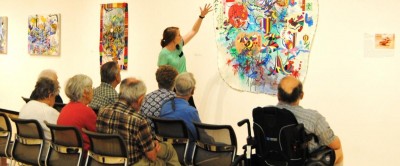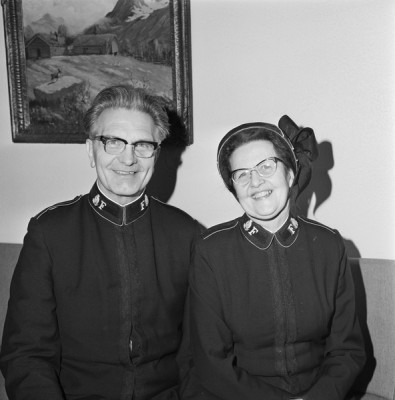Creative aging, inclusive aging: How public historians can reach seniors in new ways
07 March 2016 – Meghan Gelardi Holmes

Participants in an Arts Fusion tour discuss a work from the Taubman Museum of Art’s permanent collection. Photo credit: Taubman Museum of Art
My grandmother was well into her seventies by the time I was old enough to share in one of her favorite activities. We would meet at Penn Station and take the bus uptown to visit the newest show at the Metropolitan Museum of Art. Like many in her age group, however, such adventures were dependent upon her health and mobility, and in the last several years of her life, her and my grandfather’s world shrunk to the four walls of their assisted living facility. Much of the vibrancy and intellectual excitement those outings provided disappeared.
One in eight Americans are 65 or older; by 2030, this figure will rise to one in five. Museums have long appreciated the support of seniors, and yet, programs have not always catered to the specific needs and interests of this group. Initiatives in art and science museums and a growing body of research on “creative aging” suggests that cultural institutions can contribute to the well-being of senior citizens and seniors to the well-being of institutions. Public historians have intellectual tools and practical skills that lend themselves to working with elderly populations, including attention to the nuances of memory and narratives about the past, and experience developing meaningful, accessible programs for diverse audiences. How can we more actively and meaningfully contribute our skills to this population?
What are the right kinds of programs and exhibitions to reach seniors? How can we spark conversations about the past and harness the particular expertise and wisdom of the older members of our community? How do we accommodate challenges to physical and cognitive health? How might public history help sustain physical and cognitive health? And, when this population is no longer able to get to the museum, how can we bring the museum to them? What are the most successful models for collaboration between museums and seniors, at museums and history sites but also in hospitals, nursing homes, and assisted living centers?
In 2015, I and two colleagues realized that we had each been thinking hard about this particular dilemma. While working at the Taubman Museum of Art in Roanoke, VA, I partnered with the local Alzheimer’s Association on a program called Arts Fusion, where museum docents lead focused tours of the collection for dementia patients and their caregivers. The program training forced me to think hard about how our museum was and wasn’t poised to work with the elderly population.

Salvation Army officers Haakon and Eili Dahlstrøm, 1972, by Rigmor Dahl Delphin. Participants at a recent Oslo i Bilder program remembered that bonnets were a part of the Norwegian Salvation Army uniform in the 1960s and 1970s. Photo credit: Oslo Museum
Meanwhile, in Oslo, Norway, Emily Oswald had begun volunteering at a senior center and using digitized historical photographs as a starting point for conversation with residents. Emily reported that sometimes the conversation was great, though it was hard to predict which images would conjure a memory or elicit an anecdote. A program at the city’s science museum for people with dementia was having similarly exciting, though unpredictable, results. Back at the University of Massachusetts Amherst, where Emily and I both studied, Marla Miller with her colleague Betty Sharpe had recently revived and reinvented a program Betty had once offered in her capacity as Director of Education at the Smithsonian Institution’s National Museum of American History. This program had involved partnering with the local historical society to bring artifacts to seniors in assisted living facilities for programs that explored American history while also helping seniors reflect on the trajectory of their own lives and the history they themselves witnessed.
While oral history has long been seen as public history work that also has tangible benefits for aging subjects, the intersection between public history and gerontology is expanding. We are all beginning to see ways that history is being more purposefully tapped in the care of aging populations, from museum programming for Alzheimer’s and dementia patients to assisted living facilities that build upon the familiarity of the past to stabilize cognitive health. What, for example, might a museum located inside an assisted living facility look like? Many local historical societies are run entirely by volunteers over 65. What if these institutions actively saw themselves as serving functions akin to local senior centers? In his book on aging in the US, Atul Gawande talks about an experiment at an assisted living facility that has residents caring for animals, to great success; there is a lesson here for public historians in finding meaningful roles for seniors by actively including them in the work of an institution.
We hope to contribute to this ongoing conversation in our session at the upcoming National Council for Public History conference, by thinking creatively about public history projects that involve seniors in deep and meaningful ways. We will share insights from the programs we’ve worked on and then hear from four professionals in the fields of gerontology, aging, and health care. Greg L. Finch, Director of Field Services at the National Center for Creative Aging in Washington, DC, will share his best practices for institutions planning arts and other creative programs for aging populations. Michiko Iwasaki is an Assistant Professor in the Department of Psychology at Loyola University Maryland and researches long-term health care planning and family caregiving. Darina Petrovsky, a doctoral student in Nursing Science at the University of Pennsylvania, will contribute perspectives from nursing and neuroscience and share her research on the impact of singing on language and memory in older adults. Lastly, Ilene Rosenthal, Program Director at the Alzheimer’s Association of Greater Maryland, who works at the intersection of social work and public policy as related to aging adults, will talk about programming for people with Alzheimer’s disease and dementia. These experts from outside the field of public history will each lead a breakout group and together, we will explore the unique challenges of working with seniors and consider programs and collaborations, including Internet-based projects, that address and even embrace these challenges.
~ Meghan Gelardi Holmes is a public historian, writer, and museum specialist. Most recently, she was the Curatorial Assistant for Adult Education at the Taubman Museum of Art, where she planned public programs and participatory art experiences for a range of adult audiences. Her work at the museum included a partnership with the Alzheimer’s Association of Virginia. Holmes received an MA in Public History from the University of Massachusetts Amherst in 2006.



